 |
>> See Past News Editions >> Click to Print Just Updated 2015 Expert’s Guide to Defensible Workfile “Bulletproof” your Workfile, protect your license and your livelihood with expert help. Make your time count: learn quick tips from an expert on how to produce highly defensible reports that keep you safe and raise the quality of your product. Click now.Just Updated 2015 AMC Guide The JUST UPDATED 2015 AMC Guide helps increase orders so you can turn down low-fee AMC work, negotiate fees from a position of strength and confidence and refuse to work for the AMCs that undervalue you. Start 2015 off with a new book of clients! Work with the best and fire the rest. Click now. |
Editor’s Note: (Are you a Working RE Subscriber?)
Clothes Dryer Vents: The Proper and the Improper
By Matthew Steger, ACI
I continually run into confusion from property owners and Realtors regarding what the proper venting material should be for clothes dryers. Statistics from the Consumer Product Safety Commission (CPSC) show that over 24,000 house fires and nearly $100 Million in property damage annually are related to faulty clothes dryer vent installations. House fires related to clothes dryer vents are much more common than most people believe but luckily are relatively easy to prevent. The photo below illustrates how dirty many dryer ducts are and most people would have no idea until they either (1.) have a fire, or (2.) decide to finally clean out their dryer vent.
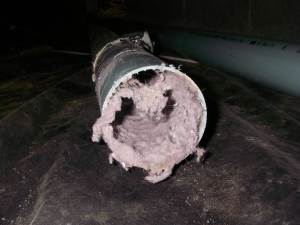
During a normal drying cycle, up to a gallon of water may be drawn out of the clothes in the form of water vapor. The purpose of the dryer vent system is to transport this water vapor, and the lint that accompanies it, to a safe location outside the home. The most commonly seen improper type of dryer vent is flexible vinyl tubing. Vinyl is a type of plastic and it can easily melt and lead to a house fire. This material, most often white and ribbed, tends to allow for lint to readily accumulate. Lint is very flammable and all it takes is a small spark to ignite it leading to a house fire. The more lint that fills a clothes dryer vent, the more energy the clothes dryer consumes to try to dry the clothes as air won’t freely flow through the clogged vent material. This, in turn, causes the drying cycle to be much longer than normal and raises utility bills. The photo below shows an installation of vinyl tubing.
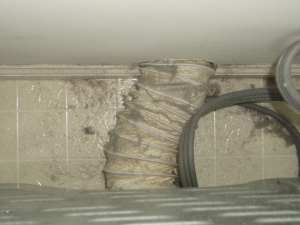
Another improper dryer vent material that I routinely see installed is mylar foil tubing. It is a flexible ribbed shiny tubing that many home owners and contractors have installed and they wrongly assume that it is metal because it is shiny. Mylar foil tubing is not approved for use as a clothes dryer vent material and should not be used for this application. The photo below shows an installation of mylar foil tubing which actually runs behind a fixed wall covering and was the only dryer vent material installed in this particular home. A few manufacturers of mylar foil tubing have been able to obtain a UL listing; these products specifically should be used as the transition duct ONLY between the dryer and the actual rigid metal dryer vent (not the full dryer vent!). It the mylar transition duct is UL approved, it will have a UL sticker on it. If it has no sticker, then it should be assumed it is not UL listed and should be replaced with a proper dryer vent material. The transition duct should be as short as possible to connect the dryer to the metal dryer vent; it should be no longer than 8′. The transition duct must not run within a wall, floor, or ceiling covering since it will not be able to be visually inspected and can’t easily be cleaned.

I also occasionally find mylar tubing venting a clothes dryer into the basement with a plastic container (see photo below). First, the tubing is incorrect. Second, venting the clothes dryer into the basement takes the moisture out of the clothes that the dryer is drying and discharges that back into the home. This creates an environment that is a fire-hazard (lint) and a mold-hazard (moisture).

Something that I’ve been running across more often lately in homes built within the past 15 years is some builders installing 4” PVC drain pipe as the clothes dryer duct. At one inspection from this past spring, I even saw a black corrugated plastic drain pipe (normally used for draining exterior water from downspouts) being used as the home’s dryer vent. While PVC is meant for plumbing and venting applications, PVC is not approved for venting a clothes dryer and should not be used for this application. PVC pipe can allow a static charge to build up; this static charge can ignite the dryer lint leading to a fire. The photo below from a recent home inspection shows vinyl tubing (left side) connected to PVC pipe (right side) with cloth duct tape.
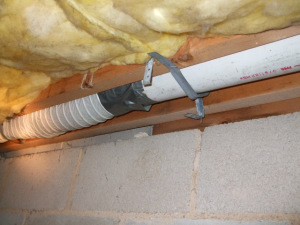
The IRC (International Residential Code) section M1501 requires that clothes dryer vents be constructed of at least 0.016″ thick rigid metal, have smooth interior surfaces, and shall not have sheet metal screws extending into the duct. The clothes dryer vent should meet the UL 2158A standard. Sheet metal screws penetrating into the material can allow lint to get caught on the screws and possibly clog the vent over time. Keep in mind, that a home inspection is not a code compliance inspection and that the AHJ (authority having jurisdiction) is the responsible party for determining/verifying code compliance. The home inspector is using these standards, however, as a reference to help protect his client from possible future hazards, such as a house fire. The photo below shows the proper rigid metal duct material. Notice how this rigid metal duct looks nothing like the mylar foil material. This material can’t easily be bent.
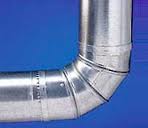
Dryer ventilation systems should only terminate to the home’s exterior and have a proper dampered exterior cover to help prevent water, birds, insects, etc. from entering the duct. The exterior cover should not have a screen since it will cause lint build up and block the vent over time. Venting a clothes dryer into a garage, basement, attic, or anywhere else inside the home can lead to excessively high humidity levels, mold, as well as an increased fire risk. Also, a clothes dryer ventilation line should terminate to an area of the home’s exterior where it cannot be blocked by vegetation, snow, dirt, etc. and be at least 3 feet from doors and windows. The vent also should not terminate near an air conditioning compressor as the dryer lint can accumulate on the A/C compressor which can prevent proper operation of the A/C system.
Flexible rigid metal ducting (this specific material is only slightly bendable) is recommended where the rigid metal duct material connects to the clothes dryer. The photo below shows flexible rigid metal ducting. Notice how different this rigid metal material below looks compared to the mylar foil ducting shown in the 3rd photo from the top of this article. If the clothes dryer and exterior vent are in close proximity, a single piece of flexible rigid metal duct (as seen below) can often be safely used as the sole duct, assuming it does not pass behind a wall, floor, or ceiling covering.
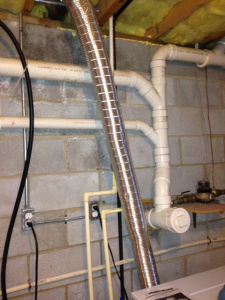
I also sometimes find dryer vents that far exceed 40 feet. I recommend that the vent system be modified to terminate to an alternate exterior location closer to the laundry appliances to allow a shorter run. Most standards call for clothes dryer vents to be no more than 25 feet in length, have few bends, and no kinks. Gas dryers, though, are often permitted to have ducts no longer than 35 feet in length. The more bends in the line that exist, the shorter the overall length should be. For every 90 degree bend, the vent should be shortened by 5 feet; for every 45 degree bend, the vent should be shortened by 2.5 feet. An exception exists if the clothes dryer’s manufacturer specifically permits a longer vent but, in most cases, the inspector does not have this documentation from the clothes dryer’s manufacturer.
With every home inspection, I always recommend that the clothes dryer vent system be thoroughly cleaned at least twice per year as preventative maintenance. A home owner can take apart and clean the dryer vent’s interior himself; this is made easier with a vacuum cleaner with a long hose attachment. Some HVAC professionals and chimney sweeps also offer dryer vent cleaning as a service.
During a home inspection, the inspector will try to determine the type of clothes dryer vent material(s) installed. In some homes, only parts of the clothes dryer vent system may be visible. Often, socks or other clothing have fallen behind the laundry appliances against the wall and these items can block sight of the dryer vent where it then passes into a wall or floor. Installed insulation, ceilings, or walls as well as other stored items in a basement can also block visual access to the dryer vent material. Of course, home inspectors do not move insulation, disassemble walls/ceilings, or move appliances to perform the inspection. Some chimney sweeps, disaster cleanup companies, etc. offer professional dryer vent cleaning. Special tools are needed to properly clean these vents, especially the longer vents. Short vents can often be cleaned by the homeowner, however.
House fires related to improper or blocked dryer vents are easily prevented and a little bit of preventive maintenance can help save lives. When was the last time you inspected and cleaned your clothes dryer vent? Your family’s safety may depend on it.
Read the entire story in the current print edition of Working RE.
Hot: On-Demand and Live Webinars
(Webinars recorded in case of scheduling conflicts.)
January
Top 5 Questions Asked of an Appraiser and How to Answer
Available Now
Do you struggle knowing whether client requests are proper or even legal? Whether they are putting your license at risk? See the most efficient way to help clients, evaluate and reduce callbacks and avoid making mistakes that can derail your career. This class provides you with the right way to handle these common and sometimes tough questions. The right answers can help protect you and make your business life easier and more profitable. Includes tips for understanding and navigating Fannie Mae’s new Collateral Underwriter.
February
Part 1: Keeping Off Fannie Mae’s New Appraiser “Blacklist”
February 5th, 10 – 11:30 a.m. PST
Part 2: Fannie Mae’s AQM and How to Stay Out of Trouble
February 10th, 10 – 11:30 a.m. PST
Hagar covers Fannie Mae’s new requirements showing you how to appraise better and avoid trouble. Hagar unravels Fannie Mae’s new AQM system and the new Collateral Underwriter requirements. The two classes will explain the 18 “deadly sins” you must avoid plus issues related to Quality and Condition classifications. The classes are designed to help appraisers avoid being blacklisted by lenders and Fannie Mae, while supplying superior appraisals for a higher fee. These are the hot topics impacting all residential appraisers.
March
How to Support and Prove Your Adjustments
Part 1: March 5th, 10 – 12 p.m. PST
Part 2: March 12th, 10 – 12 p.m. PST
Updated and expanded, Hagar shows you how to properly support your adjustments- the most important topic of 2015! Regulations state that appraisal adjustments cannot be based upon an appraiser’s opinion. Failure to provide proper proof and analysis to support your adjustments means a rough road ahead: state board complaints, panel removal, lawsuits, even license revocation. Fannie Mae cites “the use of adjustments that do not reflect market reaction” as the number one reason an appraiser can be “blacklisted.” This training is critical in helping appraisers avoid catastrophic appraisal failures.
Enjoy Subscription Pricing: January, February, and March Webinars for just $149! (5 webinars listed above)
About the Author
Matthew Steger, owner/inspector of WIN Home Inspection, is a Certified Level 1 Infrared Thermographer and an ASHI Certified Inspector (ACI). He can be reached at: 717-361-9467 or msteger@wini.com. WIN Home Inspection provides a wide array of home inspection services in the Lancaster, PA area.
This article was authored by Matthew Steger, ACI – owner of WIN Home Inspection in Elizabethtown, PA. No article, or portion thereof, may be reproduced or copied without prior written consent of Matthew Steger.
>Click to Print
>Subscribe to Working RE Newsletters
Send your story submission/idea to the Editor: dbrauner@orep.org

